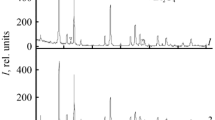Abstract—
The role of oxygen in the synthesis and phase formation of perovskite-like oxides of the homologous series Bam + nBimOy (m = 1–10; n = 0–5, 7–9, 11, 13, 17) is discussed. X-ray diffraction and chemical analysis show that Bam + nBimOy oxides are formed in air in the presence of an oxidizing agent (oxygen) through the initial stage of formation of Bi(V) enriched phases. At this synthesis stage, the Ba : Bi 17 : 9–5 : 4 samples are of the two-phase type and consist of Ba2Bi+4.78O4.39 and BaBiO3 oxides. With an increase in the temperature, the samples first undergo solid-phase transformations into Ba : Bi 9 : 4, 5 : 2, 21 : 8 oxides, and in the liquidus–solidus region, liquid-phase transformations occur with the reduction of Bi(V) → Bi(III) and oxygen loss in the presence of oxygen-deficient phases. When cooling the oxygen-deficient Ba–Bi–O melt (\(\overline {{\text{Bi}}} \) = 3.00–3.06), oxygen is absorbed, as evidenced by an increase in the average degree of bismuth oxidation with a decrease in the annealing temperature due to the oxidation of Bi(III) → Bi(V). Cooling samples of Ba : Bi 25 : 8, 11 : 4, 21 : 8, 5 : 2, 9 : 4, and 2 : 1 to 20°C results in their complete saturation with oxygen; phases 25 : 8, 11 : 4, and 5 : 2 can be obtained almost completely oxidized (\(\overline {{\text{Bi}}} \) = 4.95–5.00).


Similar content being viewed by others
REFERENCES
L. A. Klinkova, V. I. Nikolaichik, N. V. Barkovskii, and V. K. Fedotov, Russ. J. Inorg. Chem. 44, 1974 (1999).
L. A. Klinkova, V. I. Nikolaichik, N. V. Barkovskii, and V. K. Fedotov, Russ. J. Inorg. Chem. 42, 810 (1997).
L. A. Klinkova, V. I. Nikolaichik, N. V. Barkovskii, and V. K. Fedotov, J. Solid State Chem. 146, 439 (1999). https://doi.org/10.1006/jssc.1999.8390
R. von Sholder and K.-W. Ganter, Z. Anorg. Allg. Chem. 19, 375 (1963). https://doi.org/10.1002/zaac.19633190518
M. Licheron, F. Gervais, J. Coutures, and J. Choisnet, Solid State Commun. 75, 759 (1990). https://doi.org/10.1016/0038-1098(90)90241-3
M. Itoh, T. Sawada, R. Liang, H. Kawaji, and T. Nakamura, J. Solid State Chem. 87, 245 (1990). https://doi.org/10.1016/0022-4596(90)90090-K
K. P. Reis, A. J. Jacobson, and J. Kulik, Chem. Mater. 5, 1070 (1993). https://doi.org/10.1021/cm00032a007
K. P. Reis, A. J. Jacobson, and J. M. Nicol, J. Solid State Chem. 107, 428 (1993). https://doi.org/10.1006/jssc.1993.1367
M. A. Subramanian, J. Solid State Chem. 111, 134 (1994). https://doi.org/10.1006/jssc.1994.1208
N. V. Barkovskii, Russ. J. Gen. Chem. 91, 125 (2021). https://doi.org/10.1134/S1070363221010138
L. A. Klinkova, N. V. Barkovskii, M. V. Filatova, and S. A. Shevchenko, Sverkhprovodimost: Fiz., Khim., Tekh. 5, 1691 (1992).
N. V. Barkovskii, Zavod. Lab., Diagn. Mater. 85 (8), 16 (2019).
S. N. Ruddlesden and P. Popper, Acta Crystallogr. 11, 54 (1958). https://doi.org/10.1107/S0365110X58000128
Y. Shimakawa, Y. Kubo, T. Manako, Y. Nakabayashi, and H. Igarashi, Phys. C (Amsterdam, Neth.) 156, 97 (1988). https://doi.org/10.1016/0921-4534(88)90111-6
W. E. Pickett, Rev. Mod. Phys. 61, 433 (1989). https://doi.org/10.1103/RevModPhys.61.433
H. Yamauchi, M. Karppinen, and S. Tanaka, Phys. C (Amsterdam, Neth.) 263, 146 (1996). https://doi.org/10.1016/0921-4534(96)00075-5
T. A. Zaleski and T. K. Kope, Acta Phys. Pol., A 106, 561 (2004). 10.12693/APhysPolA.106.56
L. A. Klinkova, Sverkhprovodimost: Fiz., Khim., Tekh. 6, 855 (1993).
B. Yan, M. Jansen, and C. Felser, Nat. Phys. 9, 709 (2013). https://doi.org/10.1038/NPHYS2762
J. Tang, Z. Zou, and J. Ye, J. Phys. Chem. C 111, 12779 (2007). https://doi.org/10.1021/jp073344l
B. Men, J. Zhang, C. Diao, X. Li, X. Liu, and H. Zheng, J. Mater. Sci.: Mater. Electron. 29, 12729 (2018). https://doi.org/10.1007/s10854-018-9390-8
ACKNOWLEDGMENTS
We are grateful to O. F. Shakhlevich for X-ray diffraction analysis of the samples.
Funding
The work was carried out within the framework of the state task (no. 0032-2018-0005) of the Institute of Solid State Physics, Russian Academy of Sciences.
Author information
Authors and Affiliations
Corresponding author
Ethics declarations
We declare that we have no conflict of interest.
Additional information
Translated by N. Saetova
Rights and permissions
About this article
Cite this article
Barkovskii, N.V. On the Role of Oxygen in Phase Formation Involving Oxides of the Bam + nBimOy (m = 1–10; n = 0–5, 7–9, 11, 13, 17) Homologous Series. J. Surf. Investig. 16, 1164–1170 (2022). https://doi.org/10.1134/S1027451022060325
Received:
Revised:
Accepted:
Published:
Issue Date:
DOI: https://doi.org/10.1134/S1027451022060325




